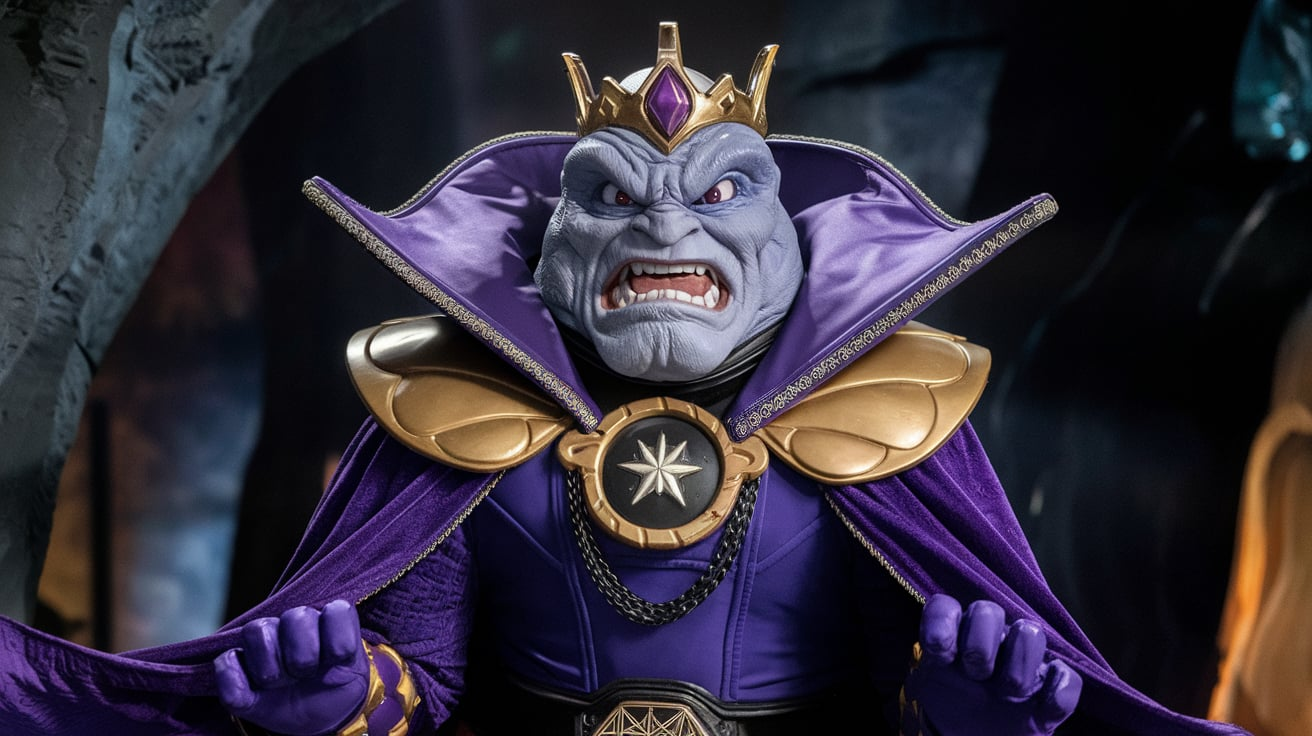Who would have thought that the infamous Lord Zedd, known for his nefarious schemes, would become the subject of a culinary conversation? “What’s for Lunch Ninnie” might sound like an unusual line from the annals of intergalactic villainy, yet it has sparked intriguing discussions among experts. This whimsical phrase has evolved, transcending its origins into a topic of scholarly examination.
The phrase “Lord Zedd Whats For Lunch Ninnie” finds its roots in a popular culture phenomenon of the 90s, capturing the imagination of enthusiasts. Such intersections of pop culture and gastronomy reflect broader societal trends, a concept as enticing as the idea of experiencing Lord Zedd’s lunchtime decisions. From televised entertainment to being a conversation starter in academic circles, this subject offers a unique melding of history and trend analysis.
Lord Zedd What’s for Lunch Ninnie is a playful catchphrase from the Power Rangers series. It highlights the humorous side of the villain, blending evil with everyday concerns like meals. This phrase often appears in fan circles and pop culture discussions, symbolizing the show’s enduring appeal and creative character depiction.

Unraveling the “Lord Zedd Whats for Lunch Ninnie” Phenomenon
The phrase “Lord Zedd Whats For Lunch Ninnie” might seem quirky to many. Emerging from the popular series, it has gained a life of its own. Fans of the character often use it humorously as a part of their daily conversations. It’s an example of how catchphrases can transcend their origins. In the ever-expanding universe of storytelling, such phrases capture widespread attention.
Understanding the significance of this phrase requires a brief dive into its background. Lord Zedd himself is a memorable villain from the Power Rangers series. As a formidable foe, he often stands out not just for his power, but also because of his unique lines. With “Whats for Lunch Ninnie,” he adds a layer of casual humor to his otherwise menacing persona. The phrase presents a delightful mix of whimsy and villainy.
In today’s culture, such phrases find meaning beyond their original context. They become memes, spreading rapidly across different platforms. Social media plays a big role in boosting their popularity. As users share and remix these phrases, they evolve into cultural touchstones. This shows how modern technology can amplify even the smallest elements of a story.
Fans have embraced “Lord Zedd Whats For Lunch Ninnie” in diverse ways. Some create artwork, other craft playful videos. From designing shirts to sharing memes, enthusiasts keep this phrase alive. Through their creativity, the phrase maintains its presence and relevance. It’s a testament to the power of fandom and pop culture.
Intersecting Pop Culture and Gastronomy
Pop culture and gastronomy may seem like separate worlds, but they often intertwine in fascinating ways. Consider themed restaurants where fans dine amid familiar settings from movies or shows. These places offer dishes named after beloved characters, bridging the gap between fans and food lovers. The experience becomes an immersive journey linking bites with entertainment. Such intersections enrich the dining experience with a sprinkle of nostalgia.
Television shows and movies frequently highlight favorite foods. Certain dishes gain fame simply because they appear in popular media. Fans try to recreate these meals at home, adding to the allure of pop culture-inspired cuisine. This practice connects audiences more deeply with the stories they love. It shows how influential media is on everyday life, even in our kitchens.
Various eateries embrace trends, designing entire menus inspired by beloved franchises. They capitalize on the popularity of shows, attracting crowds eager for themed dining adventures. From Harry Potter to Star Wars, the possibilities are endless. These establishments provide not just food, but also unique experiences. They cater to fans’ excitement, drawing them into a real-life piece of their favorite stories.
Such culinary experiences aren’t just about eating; they become events. Food festivals dedicated to iconic shows showcase this blend of pop culture and gastronomy. Enthusiasts gather, celebrating their favorites with specially crafted dishes. Social media buzz amplifies these moments, spreading the excitement worldwide. This dynamic blend of food and fandom keeps fans engaged long after the credits roll.
The Origin of “Lord Zedd Whats for Lunch Ninnie”
The phrase “Lord Zedd Whats For Lunch Ninnie” first emerged in the 1990s. It was popularized by the hit TV show Power Rangers, a series that captivated audiences worldwide. Known for its thrilling battles and colorful characters, the show was a staple of Saturday mornings for many kids. Lord Zedd, an iconic villain from the series, was both fearsome and entertaining. His unique lines often became part of fans’ everyday conversations.
The origins of such catchy phrases often stem from unexpected moments within the show. When Lord Zedd questions what’s for lunch, it combines humor with his sinister nature. This juxtaposition creates a memorable moment that resonates with viewers. By weaving in casual lines, the show cleverly builds character depth. It makes Zedd more relatable, despite his villainous role.
Fans of Power Rangers quickly embraced this quirky line, using it as an inside joke. They enjoyed quoting their favorite characters, bringing show dialogue into real-life settings. Soon, it wasn’t just fans; even those unfamiliar with the show heard the phrase. Its catchy nature made it stick, becoming part of broader pop culture. As days went by, it etched its mark on the 90s nostalgia.
This seemingly random line took on a life of its own beyond the episode it appeared in. It became more than just a part of the script. In fan circles, it serves as a reminder of the fun and excitement of being young and watching Power Rangers. This shows the lasting impact of catchy dialogue in popular media. Such phrases continue to bring smiles to fans, long after the show aired.
Implications of “Lord Zedd Whats for Lunch Ninnie” in Modern Culture
The phrase “Lord Zedd Whats For Lunch Ninnie” has surprising implications in modern culture. It illustrates how a simple line can evolve beyond its original context. This meme-like catchphrase has proven its longevity by adapting to new platforms. Social media networks have helped in spreading its popularity wide and far. This demonstrates how lines from the past find new relevance today.
People often use this phrase humorously in everyday life, creating connections among fans. It stands as a talking point at social gatherings, sparking laughter and nostalgia. For fans, it serves as a shorthand, instantly recalling the excitement of the Power Rangers universe. Its use helps bridge generational gaps, bringing together those who watched Power Rangers with newer viewers. Communication through shared cultural references enhances social interactions.
Brands have capitalized on such phrases, incorporating them into marketing campaigns aimed at engaging audiences. Merchandise features these beloved lines, offering fans a tangible connection to their favorite shows. T-shirts, mugs, and even online content often reflect this lively dialogue. Such strategies show how pop culture elements can drive consumer interest. It’s a clever way to marry nostalgia with modern consumerism.
Memes, inspired by iconic phrases like “Lord Zedd Whats For Lunch Ninnie,” frequently circulate online. These often lead to creative user-generated content, offering a blend of humor and creativity. Enabling fans to express themselves with memes enriches the online cultural landscape. It empowers individuals to share memories and experiences in dynamic ways. The ability to remix and share adds new layers to cultural interactions.
This iconic phrase also reminds us of the enduring impact of childhood media. Today’s adults often reflect fondly on phrases from their favorite shows, connecting them to feelings of nostalgia. Its enduring appeal demonstrates the importance of television shows in shaping childhood memories. Such phrases linger in our cultural consciousness, connecting us to simpler times. They remain symbols of cherished moments from the past, still relevant today.
How “Lord Zedd Whats for Lunch Ninnie” Spans Different Mediums
“Lord Zedd Whats For Lunch Ninnie” has leapt from television screens to various other forms of media, demonstrating its wide appeal. Initially rooted in the Power Rangers series, this phrase quickly found new homes. It’s featured in fan-made videos and animated GIFs, capturing humorous moments in a loop. Video platforms further expand its reach, where users remix and recreate memorable scenes. This adaptability allows it to thrive in the digital age.
Print media hasn’t been immune to the charm of this catchy line. Comic books and graphic novels often include nods to Lord Zedd and his notorious lines. These printed stories provide another layer for fans to explore their favorite villains. By blending images and text, they offer an immersive experience. This mix continues to engage readers who enjoy visual storytelling.
Merchandise has also been influenced by this memorable phrase. Products like T-shirts, mugs, and stickers often feature this iconic line. These items enable fans to showcase their love for Power Rangers in everyday life. They serve as conversation starters, offering a fun way to connect with fellow enthusiasts. Popular merchandise plays a crucial role in culture, turning phrases into tangible memories.
Online forums and blogs further spread the influence of “Lord Zedd Whats For Lunch Ninnie“. Enthusiasts discuss their favorite moments and share creative interpretations. These platforms provide spaces for vibrant exchanges, keeping the spirit of the phrase alive. The discussions reflect the enduring impact of pop culture on community building. By engaging in these conversations, fans sustain a dynamic dialogue around the series.
Finally, interactive games often draw inspiration from beloved shows, incorporating phrases like this into gameplay. Players can engage with characters and reenact memorable moments. This interaction adds another dimension to storytelling, building richer experiences. By bridging different mediums, these elements enhance fan engagement. It shows how diverse platforms can enrich the legacy of a single line.
Reflecting on the Legacy of “Lord Zedd Whats for Lunch Ninnie”
The phrase “Lord Zedd Whats For Lunch Ninnie” continues to captivate audiences, transcending its origins in the Power Rangers series. Its charm lies in the unique blend of villainy with everyday humor, appealing to both long-time fans and new enthusiasts alike. This blend highlights the timelessness of creative storytelling.
As it expands across different media and culture, the phrase showcases the power of pop culture in shaping collective memories. It connects fans across generations, emphasizing the shared joy in revisiting beloved characters. Ultimately, its enduring presence confirms the cultural significance of engaging narratives and memorable lines.
FAQ:
What is the origin of “Lord Zedd Whats For Lunch Ninnie”?
The phrase of “Lord Zedd Whats For Lunch Ninnie”, originates from the popular 1990s TV show Power Rangers.
How has “Lord Zedd Whats For Lunch Ninnie” influenced pop culture?
The “Lord Zedd Whats For Lunch Ninnie” has become a meme, which inspired fan art, merchandise, and symbolizes nostalgia.
Who is Lord Zedd in Power Rangers?
Lord Zedd is the primary antagonist, known for his villainous yet humorous personality.
Why did “Lord Zedd Whats For Lunch Ninnie” become a meme?
Its quirky blend of villainy and everyday humor resonated with fans, which made “Lord Zedd Whats For Lunch Ninnie” a meme.
What legacy does “Lord Zedd Whats For Lunch Ninnie” hold?
It connects fans across generations, showcasing Power Rangers’ enduring cultural impact.







